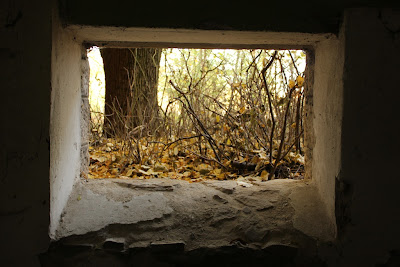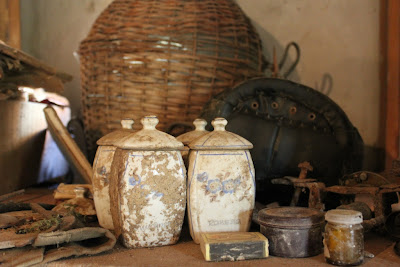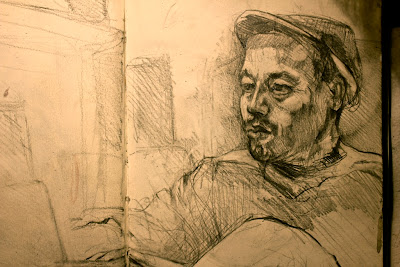Friday, November 18, 2011
The Ivancha Reclamation Project
As each of our fellow work traders left UFO Studios to continue their travels and pursuits, we began to spend more and more time getting to know Margaret and exchanging our ideas for art with her. To utilize our passion for street art, Margaret encouraged us to wheat-paste in Ivancha, even going so far as to generously allow us to dedicate our work hours to the effort. So, invigorated, we took the opportunity to do something on a larger scale than we were used to, and immediately set out into the village to scout for the most interesting areas to wheat-paste. Our wanderings culminated in the derelict schoolhouse, a massive, beautiful, and once useful building. Saddened by its condition, we felt moved to inspire a change. That, combined with the beautiful natural light flooding the building and the empty classrooms, all unique and full of curious detritus, made us feel we had found our ideal location. Our idea for a theme to unify the project was reclamation, to reclaim the neglected spaces for constructive or creative endeavors, and we spent an entire week preparing work to symbolize it.
Catherine wanted to fill an entire classroom, to open up an otherwise unused space into a place with energy and life. Honoring what has inspired her in Bulgarian communities and culture during our travels here, and hoping to evoke a curiosity about the people depicted. The images, read like stories across the walls, describe the landscape through paper-cut silhouettes and oversized portraits of women who play interesting and important roles in traditional village life: Fatme, a woman who keeps all the traditional textile patterns in her memory like a library for the other women to consult, and Thikra, the vrachka, a wise woman and powerful folk healer who makes potions and bring people all the way from Sofia to seek her help.
Roy felt compelled initially to connect with Ivancha by pasting images of her youth in the empty and disheveled rooms of the schoolhouse. To juxtapose the harsh spaces against the bright and hopeful faces of the youth as it once harbored. However, the likelihood of connecting with the scarce youth of the village was nil, so Roy decided instead to paste portraits of his friends alongside a poem for each, as a way of honoring them so far from home and sharing a personal part of his own life with the locals. Due to his plodding pace and meticulous style, he was only able to complete five drawings and five poems in time.
It took over two hours to paste all the pieces up.
It is our hope that the people of Ivancha, along with the volunteers and artists at UFO Studios, will be inspired to take part in the Reclamation project in whatever way they see fit - reclaiming and restoring Bulgaria's neglected buildings into personal, creative sites. Perhaps one day the project will spread.
Labels:
Abandoned Building,
Art Project,
Art Share,
Bulgaria,
Ivancha,
Reclamation,
Street Art,
UFO Studios,
Wheatpasting
Wednesday, November 16, 2011
Ivancha's Derelict Buildings
With a steadily declining population of only seven million inhabitants, the landscape of Bulgaria is freckled with abandoned structures. With the fall of communism, individuals struggled to find work in the rural villages they called home, and were forced to move to the cities, often abandoning their former homes entirely. In other cases, elderly individuals in the rural villages have passed on, leaving their homes to their children, which as a result of the societal changes, primarily reside in the larger cities and leave their parent's homes to rest, having no means to sustain them or market to sell them. As a result, entire villages have perished, and others have experienced exponential population loss. Ivancha is no exception to the transitions, having gone from supporting a population of over two-thousand people, to less than five-hundred in a matter of years. The village schoolhouse now rests in a state of perpetual decay, destined one day to be no more than rubble, and the percentage of derelict public and private buildings is substantial. Now, one can walk room from room through the old houses and observe a time past. Most of them are still furnished, and all are slowly being taken back by nature in one form or another - some harbor plants, rodents, or martens, and others, serpents.
UFO Studios, Ivancha
Arriving in Veliko Tarnovo late after an entire day of bus travel, we had no time to explore the heralded city, and took a taxi from the central bus station to our hostel in the old city center. Exhausted by the day's travels, we went to sleep early, and woke up early the following morning to catch another bus to the nearby town of Polski Trambesh. We had arranged for our new host, Margaret (from Glasgow, Scotland), to meet us there and take us to her home turned art project. After introducing ourselves, we piled into her sedan and drove the fifteen minute distance to Ivancha - the site of Margaret's UFO Studios, a project set to attract artists of all types. We arrived to be greeted by a gorgeous property, two playful dogs, three lovely cats, and two fellow work-traders, an American named Suchi, and her Argentinian partner, Ezekiel. Charmed by the new surroundings, we quickly settled into our new room and got to know the property, which included an orchard, several barns, a disheveled cottage, and numerous outbuildings destined to one day serve as studio, event, workshop and residency space for visiting artists.
We soon fell into work roles, with Roy mainly landscaping, pruning, and preparing wood stores for the coming cold. Catherine found herself gardening, baking, sweeping, and quickly got to work on a mural to cover an outbuilding wall. In the evening, we'd share cooking duties and occasionally play a fiercely competitive game of Scrabble with our housemates. One morning we greeted the arrival of another worktrader in Toru, from Japan, then Michael, from Scotland, and the next week, Helen and Bruce arrived to make it a full house.
Soon after their arrival, Bruce and Helen began paving a patio area using local stone, bricks, and antique bottles for accents. After finishing it, we suggested continuing it as a path around part of the garden, and asked if we could help. We enjoyed the work and spent the next week adding onto their original design to create a lovely path around the garden well. As we started the final section, Roy noticed a beautiful ammonite fossil remnant in one of the paving stones that the Australians had found earlier in the week. It ended up the perfect focus to the final section, and we surrounded it with bottles and bricks to catch the attention of future visitors.
One weekend we accompanied Bruce and Helen to Veliko Tarnovo, to better visit the picturesque city. We had a lovely time walking along cobbled streets and taking in stunning views of the cliffs along the Yantra river. Unfortunately, the galleries were closed, and most of the pubs and music venues were slow despite the presence of a university in town. On the bright side, we chanced upon some interesting shops, and Catherine managed to pick up an antique hand-knit Bulgarian wool sweater for about fifteen dollars.
We were also surprised at the amount of street art in Veliko Tarnovo, including some of the more interesting pieces we've come across in our travels.
Soon after finishing the path, we took a break from work one morning to explore the local market in Polski Trambesh. There were scores of vendors selling produce on one side, and on the other vendors sold clothing, tackle, hunting supplies, and home-made goods. Roy bought some hand-knitted socks and slippers from a lovely little old lady, and Catherine picked up some local bee pollen to spice up our morning cereal. A few days later we celebrated Guy Fawkes Day, and said a sad goodbye to Bruce and Helen, who left to continue their travels in Romania.
With the leaves falling heavily, we decided to take advantage of the remaining sun and explore the hills behind Ivancha before the inevitable cold. The landscape was beautiful in its own way, transitioning from grazing lands to pine plantings. We delighted at the sight of several pheasants (all of which eluded us for photographs), and some of the local livestock.
Labels:
Art Project,
Bulgaria,
Ivancha,
UFO Studios
Subscribe to:
Posts (Atom)


























































